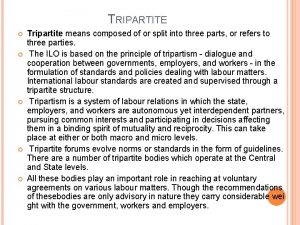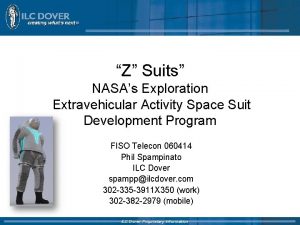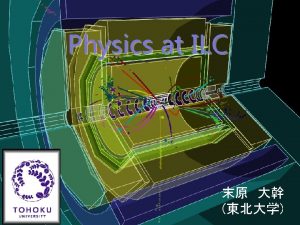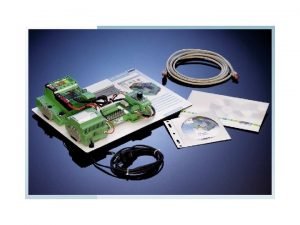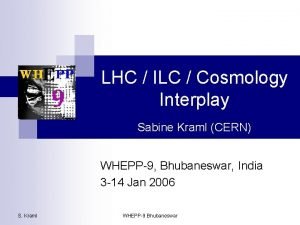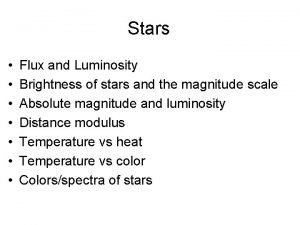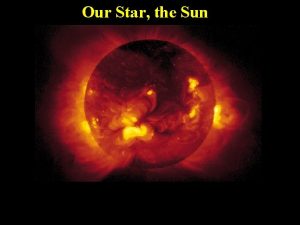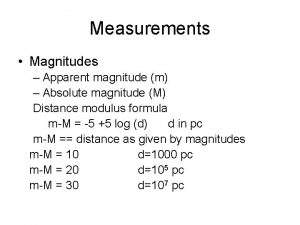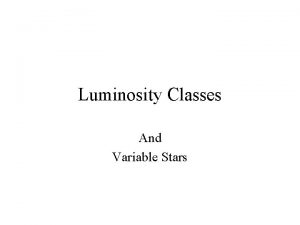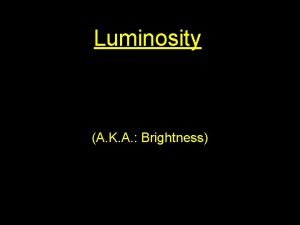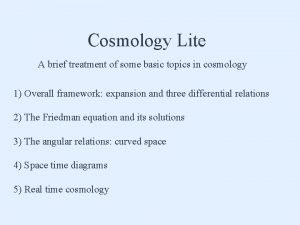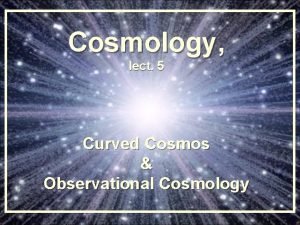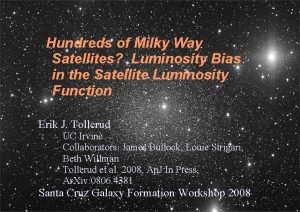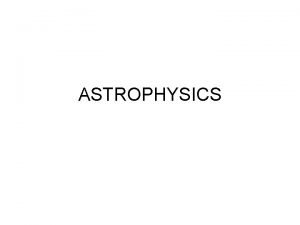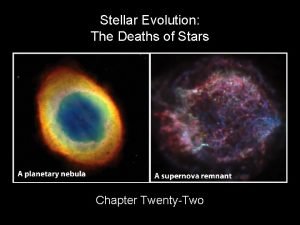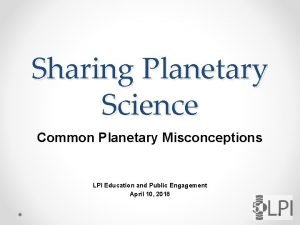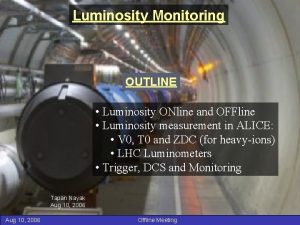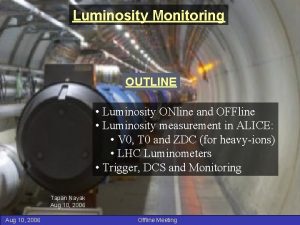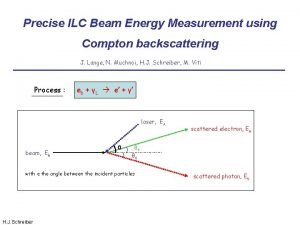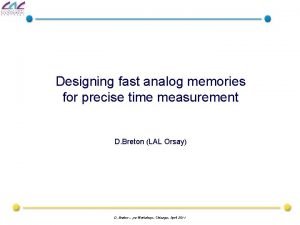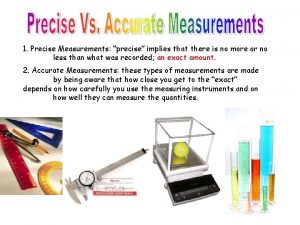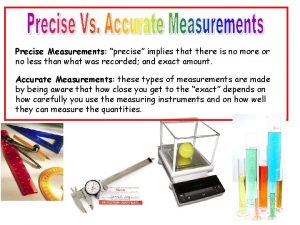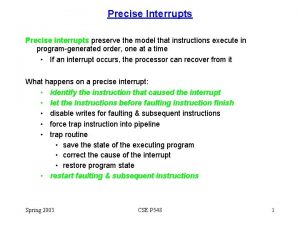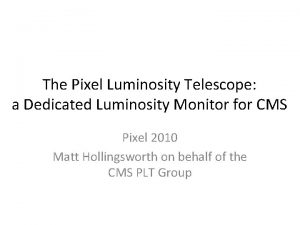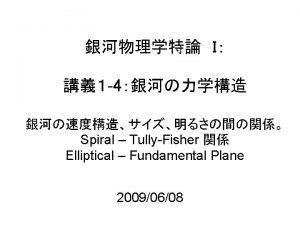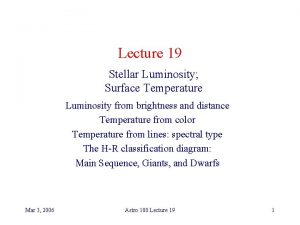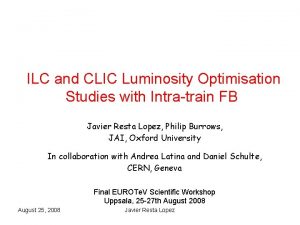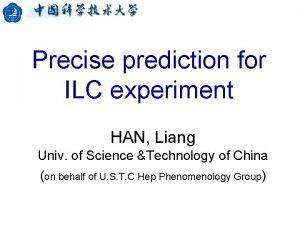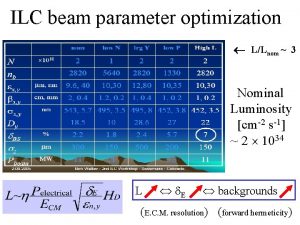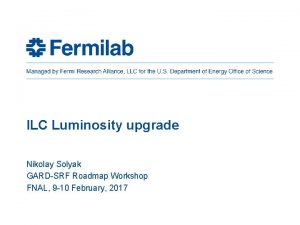Fast and Precise Luminosity Measurement at the ILC










![y [cm] Background Suppression x [cm] signal/background before (top) and after applying the selection y [cm] Background Suppression x [cm] signal/background before (top) and after applying the selection](https://slidetodoc.com/presentation_image_h2/0238b15326d7985c02453a4e4a645aff/image-11.jpg)





![observable j [au] Coefficients of the Taylor-Matrix parametrization (polynomial) slope at nom. value taylor observable j [au] Coefficients of the Taylor-Matrix parametrization (polynomial) slope at nom. value taylor](https://slidetodoc.com/presentation_image_h2/0238b15326d7985c02453a4e4a645aff/image-17.jpg)







- Slides: 24

Fast and Precise Luminosity Measurement at the ILC Ch. Grah LCWS 2006 Bangalore

Overview Ø The forward region Ø Luminosity measurement using Lumi. Cal § Requirements § Systematics § Physics background Ø Fast luminosity monitor – Beam. Cal § Using the pair background signal § Beam parameter reconstruction Ø Summary and outlook LCWS 2006, Bangalore Ch. Grah: Luminosity Measurement 2

Forward Region – New Geometry 20 mrad geometry (LDC) LCWS 2006, Bangalore Ch. Grah: Luminosity Measurement 3

Forward Region - Tasks Ø Lumi. Cal (26 (43) mrad < θ < 153 mrad) 2 mrad § Detection of low p. T em interacting particles § Measure bhahba particles with high precision Ø Beam. Cal (5. 6 mrad < θ < 28 (46) mrad) § Detection of low p. T em interacting particles § Measure and analyse the deposition from pairs originating from beamstrahlung. Ø LHCal (new idea) § Low angle hadron calorimeter 20 mrad Ø Photo. Cal (not drawn on this picture) § Analyse beamstrahlung photons in the range of ~100μrad Ø Minimize background from backscattering from pairs. LCWS 2006, Bangalore Ch. Grah: Luminosity Measurement 4

Backgrounds (Old 20 mrad Geometry) Sketch of old Beam. Cal geometry. Projection of Lumi. Cal‘s inner radius. Energy deposited in Lumi. Cal from pairs. 20 mrad DID Þ backscattering from pairs hitting the Lumi. Cal edge (K. Büsser) LCWS 2006, Bangalore Ch. Grah: Luminosity Measurement 5

Lumi. Cal Events Ø Requirements: BHWIDE generated events precision by: θ (rad) Bhabha scattering LCWS 2006, Bangalore Energy (Ge. V) Ch. Grah: Luminosity Measurement 6

Detector Performance Detector performance can be included into MC. How well we have to know? R. Ingbir LCWS 2006, Bangalore Ch. Grah: Luminosity Measurement 7

Systematic Effects Ø Changing the detector position Headon, 14, 20 mrad X-angle outgoing beam 14 mrad X-angle detector axis 20 mrad X-angle detector axis without Including bias & resolution LCWS 2006, Bangalore Ch. Grah: Luminosity Measurement 8

Compensating Systematic Effects by MC Y (cm) 20 mrad X-angle Detector axis Before correction after correction ΔL/L~10 -2 X (cm) This is assuming knowing in perfect precision many parameters! ΔL/L~10 -3 So far these effects are all considered individually, so be careful! LCWS 2006, Bangalore Ch. Grah: Luminosity Measurement 9

Physics Background M. Pandurović/I. Božović-Jelisavčić Ø Four-lepton processes are the main source of physics background for luminosity measurement Ø Simulation of e+e- -> e+e-l+l- (l=e, μ, τ) background with WHIZARD Ø and Bhabha signal with BHLUMI Ø detector simulation BARBIE for track hitting detector frontface (generated track information was used) LUMICAL BEAMCAL ≈10 -3 tracks/BX Energy [Gev] [deg] Energy and polar angle of background LCWS 2006, Bangalore Ch. Grah: Luminosity Measurement 10
![y cm Background Suppression x cm signalbackground before top and after applying the selection y [cm] Background Suppression x [cm] signal/background before (top) and after applying the selection](https://slidetodoc.com/presentation_image_h2/0238b15326d7985c02453a4e4a645aff/image-11.jpg)
y [cm] Background Suppression x [cm] signal/background before (top) and after applying the selection cuts (bottom) Ø background can be effectively surpressed LCWS 2006, Bangalore Ch. Grah: Luminosity Measurement 11

Beam. Cal e+ e- e+e- pairs from beamstrahlung are deflected into the Beam. Cal Ø 15000 e+e- per BX => Beam. Cal: 4 < θ < 28 mrad (headon) 10 – 20 Te. V Ø ~ 10 MGy per year Ø “fast” => O(μs) Ø Direct photons for θ < 400 μrad (Photo. Cal) LCWS 2006, Bangalore Deposited energy from pairs at z = +365 (no B-field) Ch. Grah: Luminosity Measurement 12

New Geometry 20 mrad DID (Ri(Lumi. Cal) = 10. 0 cm at z=2270 mm) (Ro(Beam. Cal) = 16. 5 cm) 20 mrad Anti. DID (14 mrad seems necessary for Anti. DID) An Anti. DID configuration is close to the headon/2 mrad design. BUT better be prepared for both possibilities. LCWS 2006, Bangalore Ch. Grah: Luminosity Measurement 13

Fast Luminosity Monitoring Ø Why we need a fast signal from the Beam. Cal? Ø We can significantly improve L! Ø e. g. include number of pairs hitting Beam. Cal in the feedback system Improves L by more than 12% (500 Ge. V)! position and angle scan G. White QMUL/SLAC RHUL & Snowmass presentation Luminosity development during first 600 bunches of a bunch-train. Ltotal = L(1 -600) + L(550600)*(2820 -600)/50 LCWS 2006, Bangalore Ch. Grah: Luminosity Measurement 14

Beamstrahlung Pair Analysis Ø A lot of information is stored in the energy distribution of beamstrahlung pairs hitting Beam. Cal. Ø Observables (examples): § § § § total energy first radial moment thrust value angular spread E(ring ≥ 4) / Etot E/N l/r, u/d, f/b asymmetries Ø Beam parameters § § § § § σx, σy, σz and Δσx, Δσy, Δσz xoffset yoffset Δx offset Δy offset x-waist shift y-waist shift Bunch rotation N particles/bunch (Banana shape) LCWS 2006, Bangalore detector: realistic segmentation, ideal resolution, bunch by bunch resolution Ch. Grah: Luminosity Measurement 15

Analysis Concept Beam Parameters • determine collision • creation of beamstr. • creation of e+e- pairs Observables 1 st order Taylor-Exp. • characterize energy distributions in detectors guinea-pig (D. Schulte) Taylor + nom LCWS 2006, Bangalore Matrix * Δ Beam. Par Observables = FORTRAN analysis program (A. Stahl) and/or GEANT 4 Solve by matrix inversion (Moore-Penrose Inverse) Ch. Grah: Luminosity Measurement 16
![observable j au Coefficients of the TaylorMatrix parametrization polynomial slope at nom value taylor observable j [au] Coefficients of the Taylor-Matrix parametrization (polynomial) slope at nom. value taylor](https://slidetodoc.com/presentation_image_h2/0238b15326d7985c02453a4e4a645aff/image-17.jpg)
observable j [au] Coefficients of the Taylor-Matrix parametrization (polynomial) slope at nom. value taylor coefficient i, j 1 point = 1 bunch crossing by guinea-pig beam parameter i [au] LCWS 2006, Bangalore Ch. Grah: Luminosity Measurement 17

Analysis for nominal ILC Parameters single parameter analysis Quantity ILCNOM, 20 mrad DID LCWS 2006, Bangalore sx sx sy sy sz sz y Nominal Value Precision 553 nm old 4. 8 3. 9 new 2. 9 7. 4 5. 0 nm 0. 1 0. 2 0. 1 0. 4 8. 5 6. 7 6. 3 2. 0 0. 6 300 mm Ch. Grah: Luminosity Measurement 0 18

2 mrad and 20 mrad Analysis Quantity sx sx sy sy sz sz Nominal Value Precision 553 nm 2 mrad 3. 1 5. 2 20 mrad 2. 9 7. 4 20 mrad (2 par) 2. 8 7. 6 5. 0 nm 0. 3 0. 2 0. 3 0. 4 4. 8 8. 5 11. 1 3. 7 6. 3 7. 4 300 mm εy 40 x 10 -9 mrad 1. 7 2. 9 5. 2 εy 0 4. 2 4. 1 4. 7 17. 7 9. 3 10 x y 0 0. 5 0. 6 N 2 x 1010 0. 01 N 0 0. 01 0. 02 0. 03 LCWS 2006, Bangalore Ch. Grah: Luminosity Measurement . . . 19

Beam. Cal Geant 4 Simulation Ø Need precise simulation for showering/realistic bfield map. Includes: § § § flexible geometry (beam crossing angle, layer thickness, variable segmentation, calorimeter tilt) simplified Di. D/anti. D magnetic field input – GP generated e+e- pairs output – root tree with energy distribution in segments 1 BX ~ 200 min @ 2. 4 GHz CPU Shower visualization LCWS 2006, Bangalore A. Sapronov Energy/Layer distribution Ch. Grah: Luminosity Measurement 20

G 4 Simulation with simplified B-field 20 mrad DID Deposited energy in sensor layer all layers layer 8 20 mrad Anti. DID σz, μm LCWS 2006, Bangalore Ch. Grah: Luminosity Measurement 21

Using Bfield Map Energy deposited in the sensors of the forward Beam. Cal. All layers LCWS 2006, Bangalore Layer 8 Ch. Grah: Luminosity Measurement 22

Summary Ø Redesign of the forward region has been done to cope with 20 mrad DID (worst case). Ø Lumi. Cal § Investigated physics and selection cuts to effectively reduce background. § Investigated systematic effects (displacement, resolution, bias. . ). . . and recommend Lumi. Cal to be centered around outgoing beam. § A luminosity measurement of ΔL/L ≈ 10 -4 is feasible so far. Ø Beam. Cal § Intratrain feedback of Beam. Cal has the potential to increase the luminosity significantly. § A fast beamdiagnostics has potential to access many beam parameters (intratrain). § This is also feasible for 20 mrad. § Have set up a G 4 simulation of Beam. Cal for realistic shower development and for realistic b-field map. LCWS 2006, Bangalore Ch. Grah: Luminosity Measurement 23

Outlook Ø Lumi. Cal: extend background study by detector simulation, crossing angle Ø Lumi. Cal Geant 4 simulation for both design, pad and strip version, are in work Ø Use the Beam. Cal G 4 simulation for the beamdiagnostics § Choose a subset of the detector information for the analysis Ø Detector & Readout R&D => talk by W. Wierba (DAQ session) Ø Find more details at: http: //www. ifh. de/ILC/fcal LCWS 2006, Bangalore Ch. Grah: Luminosity Measurement 24
 There are....tripartite committees at the national level..
There are....tripartite committees at the national level.. Ilc dover space suit
Ilc dover space suit Ilc 2013
Ilc 2013 Phoenix contact ilc 150 eth
Phoenix contact ilc 150 eth Zora rutar ilc
Zora rutar ilc Ilc brno
Ilc brno Spectrum ilc 1002
Spectrum ilc 1002 David i
David i Acid fast and non acid fast bacteria
Acid fast and non acid fast bacteria Acid fast vs non acid fast
Acid fast vs non acid fast The spectral sequence sorts stars according to
The spectral sequence sorts stars according to Astronomy
Astronomy At the center of the sun, fusion converts hydrogen into
At the center of the sun, fusion converts hydrogen into Absolute magnitude to luminosity
Absolute magnitude to luminosity Luminosity class definition
Luminosity class definition Luminosity vs brightness
Luminosity vs brightness Luminosity distance
Luminosity distance Cobe
Cobe Luminosity
Luminosity Which is one physical property that all stars have?
Which is one physical property that all stars have? Luminosity
Luminosity Luminosity lpi
Luminosity lpi Hình ảnh bộ gõ cơ thể búng tay
Hình ảnh bộ gõ cơ thể búng tay Bổ thể
Bổ thể
